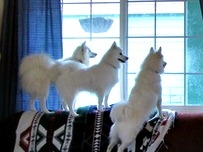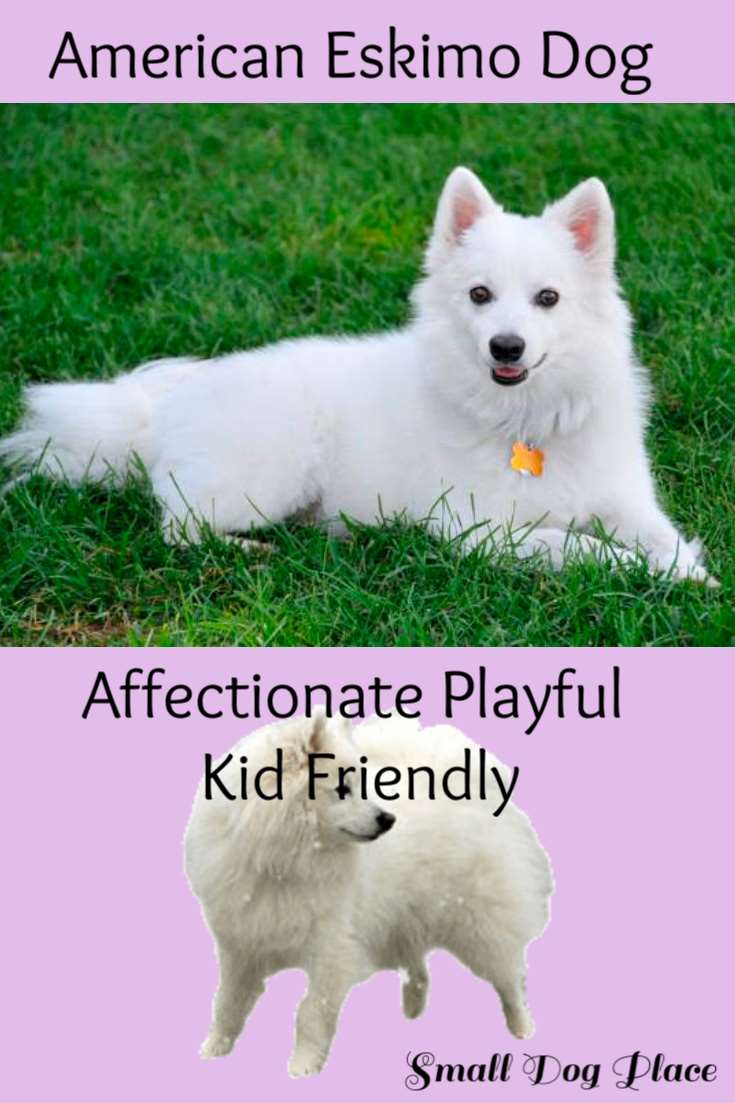- Small Dog Place Home
- A-Z Breeds A to M
- American Eskimo Dog
The American Eskimo Dog: Neither American, Nor Eskimo
by Janice Jones
If intelligence and beauty are important to you, The American Eskimo dog can deliver. These fur babies, often affectionately referred to as Eskies are alert, trainable, loyal, and friendly.
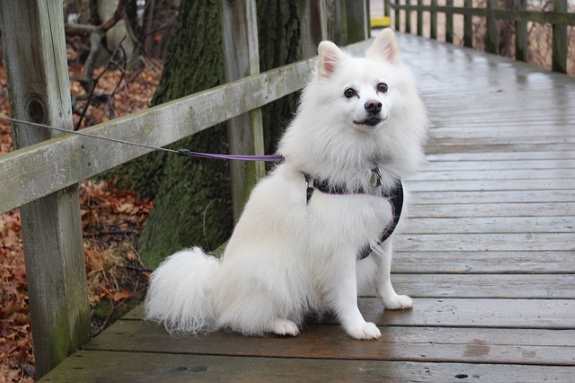 The American Eskimo Dog
The American Eskimo DogCould you ask for any more in a dog? Eskies love to play and
run around, but they also love to snuggle
and protect their owner(s).
Despite looking like a miniature Samoyed, the American Eskimo Dog is not a Nordic-type dog but does share some of the same features as one.
They have a stunning coat of hair, and distinct features on their face such as black lips, nose, and rim of their eyes.
The Eskie comes in three different sizes, much like the Poodle. These include a toy, miniature, and standard.
There are not many variations of these pups’ coats or color, but each Eskie has their own unique personality even if they all look similar.
The toy American Eskimo Dogs are a perfect size, weighing in at less than 10-pounds, which makes them the ideal lap dog and snuggle buddy.
This breed has many unique characteristics and sides to them, which make them very adaptable and suitable for a wide range of people.
If you’re looking for a versatile dog that is also highly intelligent, energetic, and loyal, then the American Eskimo Dog may be the perfect match and your new best friend.
Quick Facts
Other Names Used: Eskimo
Spitz, German Spitz, American Spitz, and Eskie
Affiliation: Non-Sporting group; AKC recognized in 1994, UKC, NKC
Size
Height: Toy: 9-12 inches
Weight: Toy: 6-10 pounds
Coat Type: Double Coat
Colors: White
Country of Origin: Germany
Activity Level: Moderate-High; this breed requires daily walks and exercise
Good with Children: If socialized and trained right, yes
Good with Other Pets: yes
History
The American Eskimo Dog was initially bred as companion dogs, despite the belief that they were developed to be sled dogs
Although they do look very similar to other Nordic-types, they do not share the desire to be sled dogs.
These guys are very closely related to the German Spitz, and despite their name, Eskies are neither American nor do they have anything to do with the Eskimo culture.
They originated in Germany and were brought to America by European immigrants.
Once they arrived in America during the 19th century, the American Eskimo Dog worked in circuses, walking on tightropes.
Circuses liked to utilize and highlight their agility, and they would even sell them to members of the audience, which was very controversial.
Personality
| Traits | Rating |
|---|---|
| Playfulness | |
| Affection Level | |
| Friendliness Towards Strangers | |
| Good with Children | |
| Good with Other Dogs | |
| Good for First Time Owners | |
| Exercise Needed | |
| Ease of Training | |
| Watch Dog Ability | |
| Grooming Requirements | |
| Shedding | |
| Cold Tolerant | |
| Heat Tolerant |
Dog Breed Ratings Got You a Little Confused?
Here's a little help in understanding them
- Playfulness: Most Playful = 5 Least Playful = 1
- Affection: Most Affectionate = 5 Least Affectionate = 1
- Friendliness Towards Strangers: Most Friendly = 5 Least = 1
- Good With Children: Great= 5 Not Good with Children = 1
- Good With Dogs: Great = 5 Not Good Around Dogs = 1
- Good With First Time Owners: Fine=5 Not Appropriate = 1
- Exercise Required: Extensive Daily Exercise = 5 Minimal = 1
- Ease of Training: Very Easy = 5 Difficult = 1
- Watch Dog: Excellent Watch Dog = 5 Minimal = 1
- Grooming: Time Consuming = 5 Minimal = 1
- Shedding: Heavy Shedder = 5 Minimal = 1
- Cold Tolerance: Well Tolerated = 5 Poor Tolerance = 1
- Heat Tolerance: Well Tolerated = 5 Poor Tolerance = 1
The Eskie was originally bred as a companion dog; however, they were also bred to guard people and property, making them excellent guard dogs.
They are also very territorial but are not considered an aggressive breed.
This particular breed is very loyal to their owners and follows in their footsteps, literally, making them the perfect shadow.
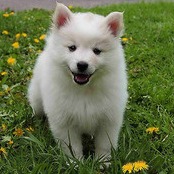 Courtesy CC Mitch D50
Courtesy CC Mitch D50Once they arrived in America during the 19th century, the American Eskimo Dog worked in circuses, walking on tightropes.
Circuses liked to utilize and highlight their agility, and they would even sell them to members of the audience, which was very controversial. American Eskimo DogCourtesy CC Mitch D50
Because they are very territorial, Eskies have the tendency to be vocal when a stranger comes around their owner or their owner’s property.
This breed is definitely smart and easily trainable, but they stay in their puppy stage for longer than almost any breed.
They take a while to mature and can carry puppy traits up until they are 2 years old, which is a year more than most breeds of dog.
They can suffer from severe separation anxiety or other misbehavior if they do not get the proper training from day one. They need to be socialized with children, pets, and other people if you want them to be on their best behavior around strangers.
Since they are intelligent and easily trainable, they pick up on new behaviors and tricks extremely quick and rank in the top breeds for agility competitions.
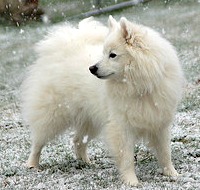 Courtesy CC Stefrobrts
Courtesy CC StefrobrtsEskies love to please but need to be in an environment with a firm, confident, and consistent pack leader.
Without this, they might think that they are the leader of the house, which can lead to behavior issues such as excessive barking, unnecessary aggression, etc.
They need a right amount of both mental and physical exercise, or they can become frantic and high-strung which could cause them to excessively spin in circles.
Suffering from Small Dog Syndrome is a real possibility for this breed.
Because they are small and cute, owners can tend to ignore the wrong behaviors, which can end up bad for the both of them in the long run.
They need daily exercise to help them release pent-up energy since they are such energetic dogs.
Being a very versatile breed, they can live almost anywhere from a large house to a small apartment.
They just like to be near their owner at all times. If you’re considering this breed and have babies in the house, the Eskie tends to start to worry when the baby starts crying.
They will worry until you let them know that there is nothing to be worried about. This is a unique characteristic of the American Eskimo Dog that could either be a good trait, or a bad trait, depending on your lifestyle and living conditions.
Grooming the American Eskimo Dog
Since the Eskie has a coarse double coat, they require a decent amount of grooming and brushing. You can take one look at them, and know that they need special attention when it comes to their coat.
Although they have a lot of hair, it’s easy to groom and brush and should be brushed at least twice a week, but daily when they are shedding. This breed is an average shedder, but they do not blow their coat.
A good pin brush will work well with this type of coat.
Along with the routine brushing, they need to have their eyes, ears, nails, and pads checked routinely also.
Hair continues to grow between the paw pads, and this can be trimmed with a small pair of blunt-tipped scissors.
This breed is prone to tear stains, which is when their tears gather under their eyes. This can be a breeding ground for bacteria and yeast though it is quite harmless. Try and keep this area clean to prevent discoloration.
Bathing is usually manageable with this breed. Before bathing, be sure to brush out any tangles or mats that have developed. Use a good quality shampoo and conditioner. Either dry the coat naturally or use a hair dryer on the cool setting. If the hair dries naturally, you will need to brush it out again after it is dry.
Health Concerns
This is a fairly healthy breed, but irresponsible breeding can cause hip and eye problems. If anything seems out of line, then contact your vet immediately just in case. Pay close attention to the tear stains and eyes.
Some may be allergic to fleas, so that is also something to keep in mind. This is a breed that can tend to be overweight if not given proper exercise. Be careful not to overfeed your Eskie. Other than that, this is a very healthy breed, but consider the following health concerns.
Pros:
- Easily trainable
- Amazing watchdog
- Generally healthy
- Protective of family
- Friendly and loyal
Cons:
- Can be vocal
- Allergies and tear staining are common
- Requires regular brushing and grooming
- Sheds regularly
- Some prone to separation anxiety
Additional Resources
Breed Club:
Rescue:
https://www.eskierescuersunited.org/
What Real American Eskimo Dog Owners Say About Their Dogs
Daisy
I will tell you that this is the smartest breed that I have ever owned. I have owned labs, retrievers, shepherds, and beagles.
They are so smart that mine has learned spelling recognition such as walk and cookie (what we call dog treats). American Eskimo dogs are great with kids and other pets. They are easily trained and love interactions with people and other animals.
I personally don't think they get enough recognition for being the perfect family pet.
Rufus became my best friend in mid-May of 2003. He was a willful and playful puppy. I was by myself and through my first year of graduate school.
The first night I had him, he peed on my head. The second night, I tried to put him in a crate, and his crying sounded like a baby crying (no, really). neighbors in my building (apartment complex) and the building beside us were all walking outside in the middle of the night wondering if a child was being abused. None of this is an exaggeration.
He was willful, but he was sweet. I was 23 and clueless as to what I had gotten myself into.
As he grew older, he had extreme separation anxiety. He got to the point where he would bark and nip at my shoes (without any teeth) when I tried to leave. Then he would cry. He was extremely protective.
There was a hit-and-run in my parking lot at age 1, and they hit him going fairly fast. We heard him yelp (he was always by my side, and I had taken him off the leash for a SECOND.
I turned my head, and he was gone). We got him to a vet, and his back leg was shattered. It was reconstructed with a metal rod. His recovery was remarkable. He jumped on it and ran on it as if nothing had ever happened.
I did not socialize with him as well as I should have after he reached about two since I was always working or there with him (and friends came and went in the apartment), so he became more attached to me and less trusting of other people.
I tried training. When I tried training, the trainer threw (yes, threw) him into a submissive pose on his back and Rufus turned into Cujo.
The woman told me I needed to put him down immediately. I performed the same submissive pose with him (placing him on his back), and he was perfectly nice. That ended with pet training.
If they aren't socialized properly, these dogs don't get along with people as well. He was very gentle around small children and seemed to understand how to interact with them.
The same with the elderly. He loved playing with dogs and cats (until cats started attacking him).
People my age, however, took a while to get adjusted. He had a special caution with men. He was wary of them, and if I had a date, he sat in between us.
He bonded with one boyfriend but not to the point where the boyfriend felt completely comfortable with him without me there.
I got another dog to keep him company. I got a 2-pound chihuahua (full size).
While they weren't close friends, they became dependent on one another. They interacted well all the time until Rufus became very food-aggressive in his middle age.
I met my future husband when Rufus was 5, and it took a while for him to adjust. He was relegated to the floor at night (after we had become engaged) and Rufus didn't prefer that.
I had let him stay on the bed, but he ate the sheets—he liked the taste of sheets. I tolerated holes, but my fiancée did not.
Rufus loyally slept by my side on the floor until a couple of months before he died.
Rufus had many quirks. If someone swept their foot in front of him, he tried to bite. Later, I found out this could seem like a kick. My mother-in-law did this and thought he was dangerous after that.
He was incredibly food-aggressive as he got older, and I begged people NEVER to feed him, people, food.
My sister-in-law fed him French fries once, and he bit the tip of her finger. She thought he was dangerous, too.
I feel like both situations did not reflect on the dog as much as knowing how to interact with the dog.
I was told he would be terrible with my daughter when I had a child and that I should keep him far away.
Rufus

by Jennifer (Raleigh, NC)
Rufus was my first child. I loved him deeply. I slowly introduced them. I have videos, and their relationship was quite beautiful.
He viewed her as an extension of me. He slept by her while she slept. She learned to be very kind, calm, light-handed, and soft-voiced. I proved those people wrong. She has mourned his death.
He had retinal atrophy. That was difficult. About a year ago, his eyes started getting cloudy, and they said it was worse than your normal sight loss. He never had hip problems. He got local prostate cancer and was diagnosed in September 2017.
It was small but inoperable. We did radiation and chemo, and he responded well, but still, it spread to the lungs. He went downhill slowly but started experiencing seizures and passed away in my arms on June 4, 2018.
I explain all of this because he was a temperamental, pretty stereotypical American Eskimo.
It took knowledgeable groomers (familiar with the coat AND temperament of the breed), vets that understood the breed and respected the quirks, but ABOVE ALL, an owner that learned (or already knew) the responsibilities of an American Eskimo dog and what special characteristics to watch for him and other people.
He was not everyone's cup of tea, and if he had been better socialized, he might have been more social and friendly.
I know that now. He would have been protective just the same. I did not express enough dominance.
Still, he made the past 15 years EVERYTHING. The house feels empty without him. These dogs change your life.
He never let me go into a room without following me. If I got sick, he was right beside me. When he got sick, I was more than happy to return the favor.
They are a huge commitment, but the rewards far exceed the work. If I could have kept him here, I would have done just about anything.
Make sure you do your research if you're thinking of getting one, but also realize it's a long commitment. I wanted that commitment, and I'll want it again.
I know it won't be Rufus, but he wasn't a jealous dog. He knew he was my "person" and was secure in that. I'm getting his ashes blown into some glass to wear as a necklace.
You'll find that most owners have stories like mine and are as obsessed with their Eskimos as I am with mine.
They are love.
Luna

We adopted Luna 6 months ago. She previously lived in an outdoor pen with 16 other dogs. She is currently 2 years old and still adapting to life with her human family. She has strong guarding tendencies toward her human mom, particularly overnight.
Luna is a bit hesitant about going outdoors, but she's getting better every day. She's a high-energy dog, and even with 2 daily walks, she could use more activity. We're helping her learn appropriate interactions with people, and she's starting to get along with the other small dogs in our family.
She weighs 16 lbs. compared to the older dogs' 7 lbs., but she is learning to heed the older dogs' "advice." Luna has a strong will when it comes to getting what she wants. She needs us to be good, consistent pack leaders to maintain balance in the house.
She is affectionate, attentive, and adorable, and we look forward to many happy years with our little Luna.
About Janice (author and voice behind this site)
Janice Jones has lived with dogs and cats for most of her life and worked as a veterinary technician for over a decade. She has also been a small-breed dog breeder and rescue advocate and holds academic training in psychology, biology, nursing, and mental health counseling. Her work focuses on helping dog owners make informed, responsible decisions rooted in experience, education, and compassion.
When not writing, reading, or researching dog-related topics, she likes to spend time with her six Shih Tzu dogs, her husband, and her family, as well as knitting and crocheting. She is also the voice behind Miracle Shih Tzu and Smart-Knit-Crocheting
Does This Article Deserve Your Thumbs Up?
We always appreciate your support and encouragement. Your thumbs up means so much to us. Please like this article.
If you find this page or any page on Small Dog Place Helpful, or useful in anyway, I'd love it if you would click the small heart found on the bottom right of each page.
You can also share or bookmark this page -- just click on the:

Free Monthly Newsletter
Sign Up for Our Free Newsletter and get our Free Gift to You.
my E-book, The Top 10 Mistakes People Make When Choosing a Dog (and how to avoid them)
